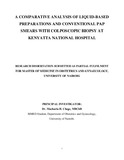| dc.contributor.author | Macharia, H C | |
| dc.date.accessioned | 2013-06-03T09:49:51Z | |
| dc.date.available | 2013-06-03T09:49:51Z | |
| dc.date.issued | 2000 | |
| dc.identifier.citation | Research dissertation submitted as partial fulfilment for master of medicine in obstetrics and gynaecology, University of Nairobi. | en |
| dc.identifier.uri | http://erepository.uonbi.ac.ke:8080/xmlui/handle/11295/28681 | |
| dc.description.abstract | BACKGROUND: Cervical cancer is one of the most common female malignancies worldwide.
Since the introduction of conventional Papanicolaou smear mortality from cervical cancer has
reduced considerably. Despite its success, it has sensitivity of only 51% and false negative rate
of 5-10%. Approved LBC products by FDA claim a 65-percent increased detection rate of HSIL
compared with conventional smears, as well as decreased unsatisfactory sample rates. Evidence
shows that Liquid Based Preparation is more sensitive and accurate for the detection of both
squamous and glandular lesions of the cervix. Studies of the accuracy of liquid based
preparations reports sensitivity of61-66% and specificity of82-91%.
OBJECTIVE: To compare liquid based preparation and conventional pap smears with
..~olposcopic biopsy results at Kenyatta National Hospital.
STUDY DESIGN: This was a hospital-based comparative cross-sectional study. Eligible clients
were recruited into the study by convenient sampling over a period of 4 months between August
and November 2011. ..
METHODOLOGY: Clients referred to colposcopy clinic with abnormal Pap smear results who
met inclusion criteria were recruited into the study by convenient sampling. Socio-demographic
data was collected. Before colposcopy/biopsy a split sample technique was used to collect
conventional Pap smear and liquid based Pap smear.
SETTING: The study was conducted at the Kenyatta National Hospital's colposcopy clinic.
RESUL TS: A total of 73 patients referred with abnormal pap smears who met the inclusion
criteria were interviewed and samples taken. The mean age of the patients was 38 yrs (SD +-10).
More than 50% of the patients interviewed were aware of Pap smear. Less than 20% of these had
had a pap smear before referral while 34% despite being aware about a Pap smear had not done
any before. About 45% of the patients were not aware about a Pap smear prior to referral.
Both the results of referral pap smear and repeat pap smear were predominantly squamous
lesions i.e. LSIL or HSIL.
There were more unsatisfactory smears with ~iquid based cytology 14(19%) compared to 4(6%)
for conventional pap smears.
10
Liquid based cytology had higher sensitivity in detection of both squamous and glandular lesions
than conventional Pap smear.
There was significant increase of false negatives with repeat CPAP (P <0.0001) compared to
LBe.
There was increased detection of low grade lesions with LBC 22% compared to conventional
pap smears 11% of which 29% of the samples were true LSIL on histology. This was a
significant difference for CPAP (P 0.007).
Both tests performed well in detection of HSILICIS with no significant difference when
compared with histological diagnosis .
..'#
There was significant difference with repeat CPAP for detection ofSCC (P 0.013).
However, there was no significant difference in the detection of glandular lesions for both tests.
In general, the results of repeat CPAP and LBC were in agreement with a kappa of 0.84 .
..
CONCLUSION: Liquid based cytology had a higher sensitivity of 92% as compared with
conventional pap smears' 57%. However, it had low specificity of 13% as compared with 50%
for conventional Pap smear. The positive predictive values for the two tests were the same. The
negative predictive value for liquid based cytology was higher compared to that of conventional
Pap smear. Overall, liquid based cytology is more accurate than conventional Pap smear in
detection of cervical intraepithelial lesions.
RECOMMENDATION:
1. In patients with abnormal pap smears requiring a repeat pap smear, liquid based cytology
is recommended due to its higher sensitivity compared to conventional Pap smear. .
However, the cost of this 'new technology in cervical cancer screening is more than of
conventional pap smears. In normal population, conventional Pap smear remains the
screening test of choice. | en |
| dc.language.iso | en | en |
| dc.title | A comparative analysis of liquid-based preparations and conventional pap smears with colposcopic biopsy at Kenyatta National Hospital | en |
| dc.type | Thesis | en |
| dc.description.department | a
Department of Psychiatry, University of Nairobi, ; bDepartment of Mental Health, School of Medicine,
Moi University, Eldoret, Kenya | |
| local.publisher | Medicine, University of Nairobi | en |

